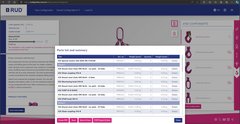New functions for the lifting means configurator
CAD data export and use on mobile devices now possible.
Since September 2022, the RUD lifting means configurator has been offering all users the opportunity to put together their own customised chain suspensions. And the free online tool is very popular: there are now around 3,000 hits per month, with users spread over 52 (!) countries, and 16,000 chain suspensions have been individually configured to date. Of course, these figures are not surprising – after all, the configurator offers a service density that cannot be found in this form with any other provider. It starts with a well-designed configuration guide that guides the user through six steps to a customised lifting solution. For this, the basic suspension parameters are entered first such as the number of strands, chain length and load capacity. The user can then take into account external factors, such as ambient temperature or shock loads, and finally step through the design of the suspension element, shortening elements, intermediate components and end component. The clever thing about it: an integrated 3D view gives the user the possibility to see the current status of their configured suspension at any time as a photorealistic 360° model which can be rotated in every direction. Parallel to each configuration step, the tool provides plenty of background and practical information about lifting and moving loads, and not least about the products and solutions from RUD. The whole thing is rounded off by the download and save functions, which make it possible to save a configuration and pass it on or to revisit it at a later date.
Targeted further development of the configurator.
You might think that it’s not possible to achieve more, but it certainly is; as the world market leader for lifting and lashing technology, RUD always endeavours not to stand still in terms of technical development and to constantly offer its users new possibilities in the field of digitalisation. Consequently, the lifting means configurator has also undergone targeted further development and now boasts two new functions. With the first of these, RUD is the first manufacturer to fulfil a long-held wish of many designers and planners – namely the wish to be able to download individually configured chain suspensions in the form of CAD data and then use them for simulations in the field of mechanical engineering, for example. Such data was already available for all RUD lifting points – it could then be exported via the lifting point configurator, for example, and further processed in CAD programmes. The export is then carried out in the system-neutral STEP format, which is compatible with all common CAD programs.
CAD data export in the STEP format now possible.
Thanks to the further development of the lifting means configurator, such data is now also available for the far more complex results of customer-specific chain suspension configurations: while registered users of the configurator could already send a request for quotation to RUD after completing the configuration or export their configured suspension with all detailed parameters as a PDF file, they now also have the option of downloading the result of their configuration as an automatically generated CAD file in STEP format. In future, this will even allow complete lifting solutions to be mapped in CAD data and further developed in CAD programs – after all, CAD data in STEP format is also available for all RUD lifting points. This makes it much easier than in the past to optimise a lifting solution to suit the components and machines involved, as well as the specific conditions of the intended application environment.
All applications now also available on mobile devices.
The second new function of the 3D lifting means configurator now points in a completely different direction. The focus here is less on planners and designers and more on all everyday users who use the configurator for the individual planning of their chain suspensions without immediately requiring more complex data records. Previously, they were dependent on a desktop workstation, as the functions of the lifting means configurator were not available on mobile devices. This has now been fundamentally changed: now the configurator, including all of the selection and export functions can be used on all smartphones or tablets. This also includes the 3D view of the configured suspension: it is available on any mobile device with a responsive design and can be used at any time during the configuration process to visually check what has been planned. This gives users the opportunity to use the configurator wherever they are and at any time and, if necessary, to put together the chain suspension they need directly on the construction site or in the production hall. And anyone who wants to can of course also request the CAD data for their configuration so that they can process it later on their desktop or pass it on to planning partners. There are no limits to the application options.




